New insights into slug control
Author: Michael Nash (South Australian Research and Development Institute, Urrbrae, South Australia) | Date: 21 Jul 2016
ɸExtra technical comment by Protech Consulting Pty Ltd
Abstract
Slug baits should be considered as crop protectants; cultural methods are required to reduce populations and the biological function of farming systems needs to be considered. Baits often perform badly and have to be re-applied due to field degradation and/or pest populations not actively feeding. Research has focused on improving bait performance.
Baits have a limited field life, with the commonly used bran based metaldehyde products (e.g. Meta) lasting less than two weeks, thus need to be applied regularly. Rainfall not only physically breaks down bran pellets; it causes a reduction in number of individuals killed. Temperature, not UV light, also reduces the efficacy of metaldehyde baits. Choose the product based on cost and the context in which it will be applied. Different products perform differently. Rules of thumb: do not use current iron based baits when >10mm rain is expected; do not use metaldehyde products over the summer and expect them to last.
The role of crop rotations needs to be considered: canola leads to a build-up in numbers; linseed has been found to limit slug populations. How will early sown canola influence slug populations?
Cereals can tolerate more slug damage than canola. UAN applied at 30L/ha can be used to repel slugs from feeding on wheat seedlings. Baits at sowing are required in high risk situations to prevent seedling damage from slugs feeding in the drill row. Loss of seedlings (plants) causes the greatest reduction in yield for cereals, with yield loss due to leaf area reduction still not quantified.
Slugs can be controlled in no-till, full stubble systems once growers understand the context of where and when controls are applied, and follow a few basic guidelines. Bait needs to be applied when slugs are active and feeding, with the timing varying depending on paddock and seasonal conditions and the species present. Basic rules of thumb for applying bait: at sowing after rolling to prevent seed and seedling damage.
Background
Several exotic slug species of European-Mediterranean origin have established in Australia and become significant pests of grain crops. Slugs are particularly damaging to establishing canola, with yield losses in untreated areas of experiments at 60-80 per cent (GRDC DAS00134 data). Bait costs are $30-$50/ha with 95 per cent of canola in the high rainfall zone (>500mm annual rainfall) of western Victoria sown into burnt and/or cultivated ground (M Nash, pers. comm). In Tasmania expenditure on bait would exceed $90 ha where multiple applications of high quality products are used in order to establish poppies, still with some control failures experienced in extremely high risk situations. In western Victoria, baiting equipment has been added to machinery so baits are applied during the sowing operation. In all operations, baiting is just one part of the year-round control program with cultural methods vital; including cultivation that produces a fine tilth and rolling for slugs.
Where slugs are a high risk (SE SA and western Vic) growers have shifted from growing canola and/or have implemented strategic burning and cultivation. That opportunity cost is estimated upwards of $270 million annually lost to the canola industry alone. A five per cent production loss by slug and snail activity would represent >$82 million loss to the Australian canola industry (2012 values).
The overall aim of research presented in this paper is to improve decisions on bait applications due to the limited field life of current products and the variable feeding of the targets; that is slugs do not always feed on baits. The first aim is to understand factors that lead to the degradation of bait products and compare the field life of various products. The second aim is to understand activity and feeding triggers, and what seasonal factors lead to greater pest numbers.
Methodology
Bait degradation
A number of experiments were conducted to give a range of conditions and test the effect of exposure time, and subsequently tease apart individual factors; temperature, UV, rainfall and mould. Bait products were weathered by spreading approximately 50g of each on the surface of soil (Warooka red loam) in large planter trays (400 x 300 x 120mm). Trays were placed on benches in an exposed position at the Waite Campus, Urrbrae, SA. Baits were exposed to weathering for seven periods during 2014, at seven day intervals (0, 7, 14, 21, 28, 35) resulting in a variety of conditions. Rain fastness of 16 different products was assessed twice by exposing to rainfall (>35 mm) over 14 days in 2015. Italian snails (Theba pisana) were used to test the efficacy of molluscicidal baits once they had been exposed to the environment on soil. Five snails, eight replicates per treatment (n=40) were added to each test arena with eight baits as soon as practicable following the completion of weathering periods (usually within 1 week). Baits were removed three days after initiation of the experiment due to the formation of mould, which was scored as present/absent and the number and condition of pellets remaining recorded. Snail mortality was assessed five days after bait was removed.
Slug activity
Three paddocks across southern Australia have been intensively monitored using cameras to capture slug activity (see blueprint on how to conduct remote sensing of snails). Environmental data was also collected: soil moisture and temperature (10cm); ground leaf wetness, temperature and relative humidity. Rainfall and barometric data was obtained from BoM. Slugs were collected each month if active from 20 surface refuges per site, which were also used to assess abundance. Slugs were weighed within 24 hrs and dissected to determine reproductive maturity.
Effects of crop type on population increases
Eggs were collected from field adults in the lab and once hatched neonates were placed on seedlings of various crop types in order to determine their growth rate. Three individuals were kept per container (100ml plastic container 55mm dia) at 100 per cent relative humidity with a 12:12 light cycle and 10:14 °C temperature cycle. Slugs were reared to maturity on each of the six crop types (Table 1) and then placed in larger breeding containers (5 individuals per 500ml rectangular plastic container) that contained soil. This next generation (F2) of eggs were collected, hatched and reared to in order to determine the intrinsic growth rate (Rm ) as per methods used previously.
Effects of temperature on slug mortality
To ensure slugs used in this experiment were a known age, grey field slugs were reared from eggs collected over a four week period from adults that were bred from a population collected from Richmond, Tasmania in 2014. Slugs were reared in groups of 10 in containers in which wheat was growing and kept at 100 per cent relative humidity with a 12:12 light cycle and 10:14 °C temperature cycle. Individuals were weighed and placed without food in individual containers lined with wet filter paper at the two temperatures (individual CT cabinets) prior to exposure to baits for 48 hours. Individual baits (Meta, Metarex or Metarex without active herein referred to as placebo) were weighed and placed into individual containers and removed after three days. Slugs were scored dead or alive seven days after baits were placed into containers.
Results and discussion
How will the latest research findings affect management strategies and packages?
Research findings regarding the field degradation of baits are presented to inform management about their likely efficacy under various weather conditions. Manufacturers often make claims about rain fastness; however these are based on physical integrity that was found not to influence actual efficacy (Figure 1, Table 2). Conclusions from this work:
- Rainfall erodes physical integrity of bran-based baits.
- Mould on products did not influence bait consumption nor efficacy.
- Reduction of active ingredient by rainfall (metaldehyde & iron chelate) is most important:
- Individuals are more likely to consume a sub lethal dose.
Don’t use current iron based baits when >10mm rain is expected. The bait's efficacy will decrease as soon as it's exposed to rainfall.
- Temperature, not UV light, degrades metaldehyde baits.
Don’t use metaldehyde products over the summer and expect them to last > 2 weeks.
- Commonly used bran products need to be re-applied after two weeks, more expensive products will last 3-4 weeks.
- Work out the cost benefit yourselves!
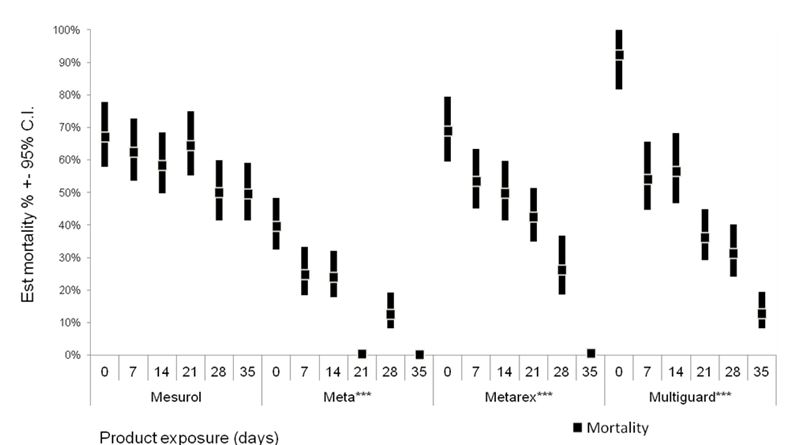
Figure 1: Product degradation (as measured by snail mortality %) in response to exposure to various weather conditions in 2014.
Overall estimates from seven experiments are presented as mean mortality and 95 per cent confidence intervals, calculated from estimating number of dead snails using GLM model (Poisson, log link). Significant effect of exposure time is indicated by *** (P < 0.001).
| Product | Active Ingredient | Label Rate kg/ha | Baits / kg | Baits / m2 | A.I. g / kg | Pellet | Efficacy 2 weeks after rain (35mm) | Spreadability | Distance (base on twin spinner machine) spread | Approximate retail cost / kg |
|---|---|---|---|---|---|---|---|---|---|---|
| NA | Metaldehyde | 3 | 100,000 | 30 | 30 | flour | Reduced | Poor | 18m | $8.00 |
| Metarex® | Metaldehyde | 5 - 8 | 60,000 | 30-50 | 50 | flour | Similar | Good | 22-24m | $9.00 |
| Metarex Micro | Metaldehyde | 5 drilled | 100,000 | - | 50 | flour | Reduced | - | - | $10.00 |
| SlugOut® | Metaldehyde | 10 | 85-93,000 | 85-93 | 18 | granule | Reduced | Good | 24m | $6.00 |
| Meta® | Metaldehyde | 7.5ɸa |
24-27,000 | 18-21 | 15 | bran | Reduced | Poor-fair* | 20-24m | $1.50 |
| Slugger® 2.5mm | Metaldehyde | 5-7.5 | 21-25,000 | 11-19 | 15 | bran | Reduced | Poor-fair* | 20-24m | $1.50 |
| Pestmaster® 2.5mm | Metaldehyde | 5-7.5ɸb | 26,000 | 13-20 | 15 | bran | Reduced | Fair* | 20-24m | $1.50 |
| Multiguard® | Iron chelate | 5-16 | 18-24,000 | 9-38 | 60 | bran | Reduced | Poor-fair* | 20-22m | - |
| Eradicate® | Iron chelate | 5-16 | 26,000 | 13-42 | 60 | bran | Reduced | Fair* | 20-24m | $4.00 |
| Mesurol® bait | Methiocarb | 5.5ɸc | 30,000 | 17 | 20 | bran | Similar | Poor* | not tested | $8.00 |
Products should always be applied as per label recommendations where these are available. This table is provided as a guide only. Some rates vary due to inconsistency of pellets/kg. Rates (kg/ha) that result in bait densities greater than what is considered the absolute minimum for slugs (>25/m2) are in bold.
Label recommendations for bran based baits can be misleading (e.g. Slugger rate 500 kg/ha which is equivalent to 50g/m2 around individual plants) hence the rate used in broadacre is often 5-7.5kg/ha). Efficacy two weeks after rain was assessed by SARDI using a bioassay with non-significant changes in snail mortality reported here as similar. Data obtained from Ashley Wakefield spreader trials is indicated and presented as provided. Always calibrate and check bait distribution for individual situations. *Field results indicate the break up, hence spreadability of bran products varies depending on batch. Prices are indicative and provided as a guide only.
ɸaRegistered label rate is 5-7.5kg/ha ɸbRegistered label rate is 5g/m2 ɸcRegistered label rate is 5.5kg ha or 11-22kg/ha. For most infestations apply low rate.
Slug research
GRDC fast track project (SAM0001) found the accuracy of bait placement around emerging seedlings gave no significant improvement in protecting the crop from slugs (Appendix A). Canola can be established with disc seeders into stubble in the HRZ as long as some basic rules around timing of bait application are followed. Soil moisture at 50-60cm was associated with increased grey field slug activity at the soil surface as recorded by using surface refuges during this fast track project. Black keeled slug activity is suspected to be triggered by moisture deeper in the soil, hence the current hypothesis is 75mm-100mm of rainfall is required over a three week period in the autumn for populations to become active. Ongoing research is testing this and investigating species differences with 2016 data from western Victoria supporting this hypothesis (Figure 2).
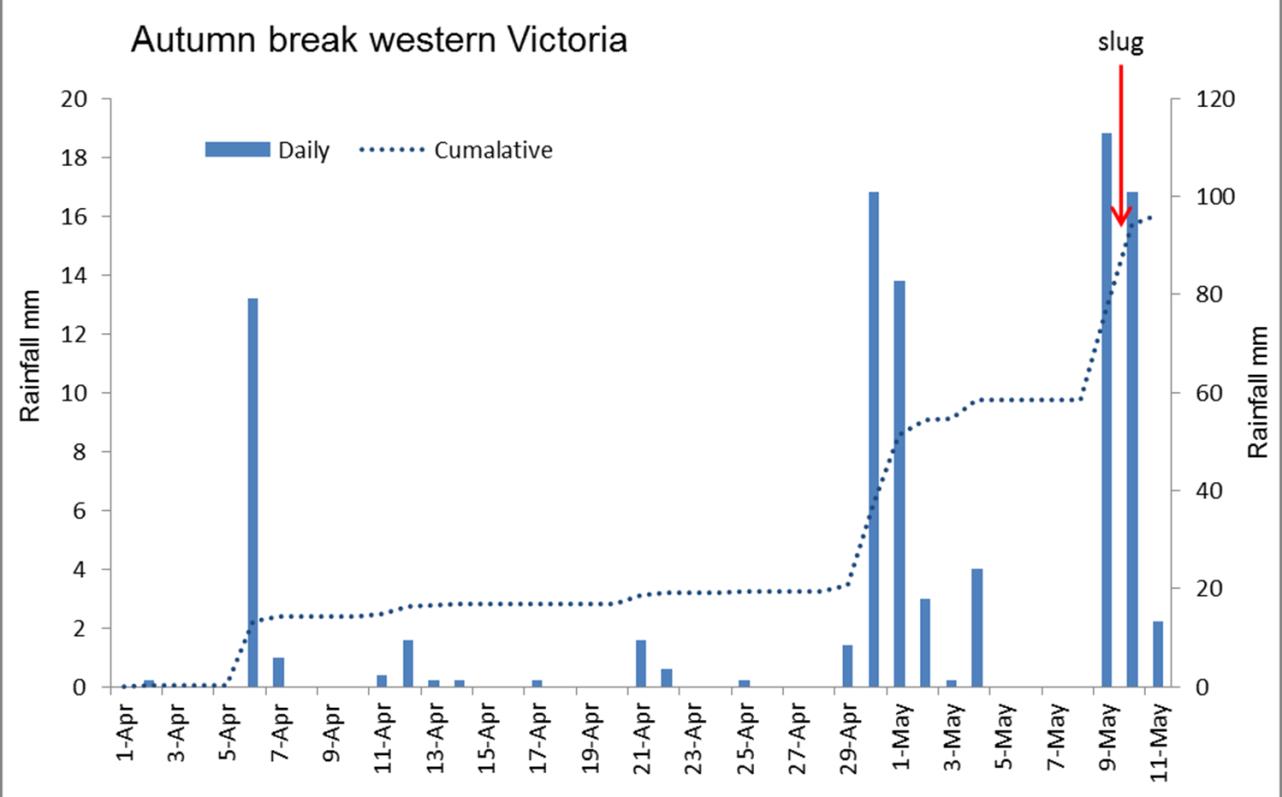
Figure 2: Black keeled slug activities in response to rainfall from western Victoria in 2016. The arrow indicates when slugs were first observed moving using time lapse cameras (9/10 May). Dashed line indicates cumulative rainfall since 1st April 2016.
Effects of crop type on population increases
Lab experiments were used to determine if nutritional differences between crop types can influence slug abundance and thereby contribute to year-to-year fluctuations in slug populations in the field. Both the number of slugs surviving and the growth rate of individuals differed between six crop types, but most importantly the number of offspring produced was greatest when reared on canola. Peas and canola were the most favourable crop for grey field slugs to increase populations as measured by the intrinsic growth rate (Rm ) (Table 1) with values obtained comparable with previous studies; Rm = 0. 03. The lack of reproduction on Faba beans (cv Rana) is not supported by field observations. One likely explanation is, despite beans being a poor food source for slugs (hence beans are easily established where slugs are present), the micro habitat created by bean crops favours slug populations. Interestingly, linseed which had the second lowest intrinsic growth rate has an additional advantage as it is thought to dry out the soil. Preliminary data on volumetric soil moisture from paired paddocks comparing the different 2014 crops, recorded in the winter 2015 were; barley 34.0 per cent, beans 34.1 per cent, linseed 32.7 per cent, canola 34.1 per cent, wheat 41.5 per cent. Significantly lower slug populations (mean ± SE) were observed the following year after linseed paddocks compared to adjacent barley paddocks: linseed 8 ± 3.4; barley 20 ± 7.3; T test P = 0.014, n=8.
Two factors are at play when assessing population responses to crops in the field; microhabitat and nutrition. Investigations are needed to understand why populations increase on wheat, and is this a factor in canola crops being damaged as they follow wheat? Farming groups have a role in extending this lab research to the field looking at rotations as a way to limit slug populations.
Table 2: Intrinsic growth rate (Rm) of grey field slugs raised on various crops under lab conditions (100% rH, 10-14°C).
| Crop | First eggs laid | Eggs | std. dev. eggs | Neonates | Hatch rate | Rm |
|---|---|---|---|---|---|---|
| Canola | 17/11/14 | 1986 | 192 | 1204 | 61% | 0.026 |
| Peas | 24/12/14 | 1003 | 195 | 530 | 53% | 0.038 |
| Barley | 5/12/14 | 1510 | 182 | 505 | 33% | 0.021 |
| Wheat | 17/11/14 | 2178 | 285 | 492 | 23% | 0.019 |
| Linseed | 5/12/14 | 438 | 56 | 66 | 15% | 0.009 |
| Beans | 5/12/14 | 23 | NA | 0 | 0% | 0 |
Effects of temperature on slug mortality
Temperature did influence the efficacy of Metaldehyde with lower mortality of grey field slugs 8-12 weeks of age as observed in lab studies at 10°C in comparison to 14°C (Table 3). The amount of bait consumed was either similar, as for Meta that contained 1.5% Metaldehyde, or actually less at the higher temperature (14°C) whether or not the active ingredient was present. The increased consumption of bait at lower temperature even though slugs may be less active at these colder temperatures suggests the individuals still consume what would be considered a lethal dose but at colder temperatures Metaldehyde is not as active (Table 3).
The interesting result was despite all individuals used in this experiment being bred from the same population and of similar age structure their weights ranged from <50mg to > 500mg. Independent of temperature, the larger slugs were more susceptible to Metaldehyde (Figure 3). The actual amount of Metaldehyde consumed by an individual declined (µg per mg of slug) as the weight of individual slugs increased. That is, in the lab it took more Metaldehyde (µg per mg of slug) to kill smaller slugs.
These poor lab results at the lower temperature supports the use of products that contain higher concentrations of Metaldehyde over the winter, however one may question the value in using Metaldehyde once temperatures fall below 10°C when a higher proportion of the population is the smaller individuals.
Table 3: Grey field slug response to Metaldehyde at two temperatures.
| Product |
Temperature |
Mortality |
Bait consumption (mg) |
||
|---|---|---|---|---|---|
| Mean | SE mean | Mean | SE mean | ||
| Meta [1.5%] |
10°C |
7% | 4% | 8.71 | 1.14 |
| 14°C |
38% | 8% | 9.79 | 0.60 | |
| Metarex [5%] |
10°C | 37% | 5% | 11.47 | 0.72 |
| 14°C | 51% | 5% | 8.57 | 1.29 | |
| UTC |
10°C | 2% | 7% | 17.10 | 1.04 |
| 14°C | 4% | 3% | 11.34 | 0.33 | |
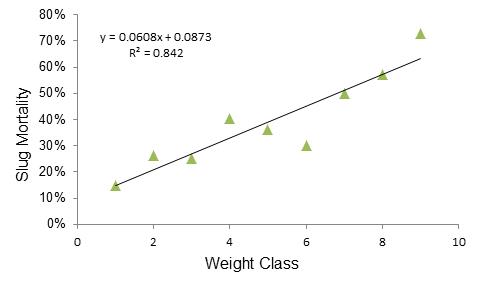
Figure 3: Mortality of grey field slug feeding on Metaldehyde baits in response to individual weight. Weight classes are in increments of 50mg where 1 = <50mg, 10 > 500mg.
Effects of nitrogen on slug populations
A field in western Victoria was used in 2015 to test if UAN could be a cost effective alternative to applying slug bait to limit damage. Repeated treatment strips 36m wide were applied: bait immediately after sowing Revenue wheat (100kg/ha) 19th May and UAN (30l/ha) applied once the crop was at the GS 1-2 and slug damage was observed. Both Meta (8kg/haɸ) and Metarex (5kg/ha) were applied directly behind the air-seeder using a third box with bait distributed by ‘spreader plates’. UAN was also applied in addition to Meta. In comparison to the Un-Treated Control (UTC) the UAN treatment did see a reduction in the number of slugs recorded from under surface refuges in the short term, however numbers did rebound after a month as did numbers in the Meta treatments. For a period after the UAN was applied no rain fell which may have aided the result observed. This result is concordant with previous studies suggesting UAN may act as a repellent for slugs; that is individuals do not feed on leaves that have had UAN applied to them (Figure 4).
ɸRegistered label rate is 5-7.5kg/ha
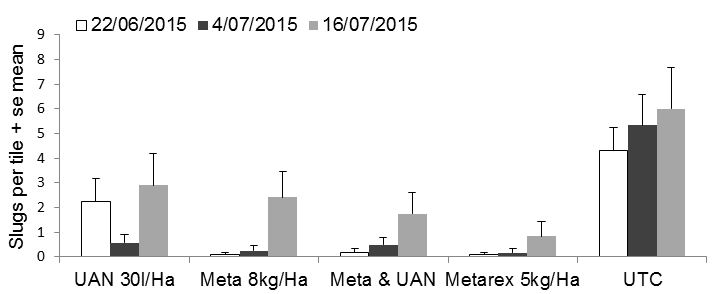
Figure 4: Slug numbers in response to UAN applied to wheat (Revenue) @ GS 1.2 (26 Jun 2016) in comparison to baits applied at sowing (19 May 2016). Error bars represent standard error of mean. ɸRegistered label rate for Meta is 5-7.5kg/ha
What are the risk factors that lead to increasing slug activity?
Improving soils and moisture holding capacity, which includes increasing macropores (porosity), organic matter and available calcium makes a more favourable habitat for snails and slugs. Moisture is the biggest determining factor for breeding, so in seasons more favourable for growing crops, populations will build up (Table 4).
Table 4: Risk factors for slug outbreaks.
| Factor | High risk | Reduced risk | Low risk |
|---|---|---|---|
| Annual rainfall | Irrigated and/or >500mm | 500mm- 450mm | <450mm |
| Spring conditions | Above average spring - autumn rainfall | Dry spring hot finish | Drought |
| Establishment conditions | Slow - i.e. cold wet conditions | Quick - i.e. warm dry conditions | |
| Stubble management | No-till, stubble retained | Burnt only | Tilled and burnt |
| Tillage | Press wheels, raised beds, cloddy seed bed | Full disturbance sowing compacted seedbed | |
| Grazing livestock | No sheep in enterprise | Sheep on stubbles | |
| Soil | Soil with improved moisture holding capacity; i.e. increased clay content and organic matter | Poor moisture holding capacity; i.e. sand no OM | |
| Weeds | Summer volunteers | No volunteers | |
| Canola crop establishment | TT varieties | hybrid varieties canola seed > 2mm | |
| Previous paddock history | Slug damage Beans/canola Sclerotinia | Clean cereal crops | No slugs Poor cereal crop No sclerotinia |
Further considerations for successful slug control
- Change crop rotation in high risk situations; look at linseed or faba beans as an alternative break.
- If growing canola sow early, ensure quick establishment by using either hybrid seed or grade open pollinated varieties (<2mm seed). Look at the use of foliar N to seedlings (GS 1.4) to ensure quick establishment in lower risk situations as a follow up after baiting at sowing.
- Under no-till and wet situations do not use bran based products that contain 1.5 per cent metaldehyde.
- Under cold conditions look at using products that contain iron chelate, when no rain is expected.
- In cereals with moderate slug risk look at UAN as a cost effective alternative to baits
Golden rules for successful slug control in western Victoria
- Cultivars or agronomic practices that ensure rapid crop establishment.
- Roll then bait at sowing.
- Follow up monitoring of emerging seedlings at least every couple days, watch for a wave of slugs mid late May especially if wet.
- Re-bait in problem areas as needed depending on weather.
Useful resources
Ground Cover TV episodes on slug monitoring and bait timing are available
Acknowledgements
Funding for this work was provided through the GRDC project DAS00134, SAM00001 and their support is gratefully acknowledged. We would like to thank Terry Horan (Roberts), Tim Pilkington (Compass Ag), Paul Breust (SFS), Ken Young and Jen Lillecrapp (GRDC), Alan Mayfield (SAGIT) and Felicity Turner (MFMG) for comments and intellectual input.
Contact details
Michael Nash
SARDI Entomology Unit, GPO Box 397, Adelaide SA 5001
08 8303 9537
michael.nash@sa.gov.au
@merindie1
Appendix A: Using precision agriculture to increase slug bait efficacy
GRDC fast track project code: SAM0001
Take home message
- The most important thing is getting the bait on at the right time and that is at sowing.
Background
The black keeled slug and grey field slug are common pests of the high rainfall zone in Victoria causing damage to emerging crops especially canola. Most growers have implemented an integrated pest management strategy that includes burning crop residue and disc ploughing soils to reduce slug habitat, and this is combined with baiting to reduce slug numbers to a safe level to allow the establishment of canola crops. These control techniques have led to an increase in potential erosion from ploughing and loss of stubble to protect the soil, as well as nutrition losses from burning residues. Some committed no-till farmers have resisted the temptation to plough and burn their paddocks, but are spending far more money on baiting strategies to protect their emerging crops with variable results. Hence we ran trials in 2014 and 2015 to test whether increasing the number of bait points around the emerging crop, by placing the baits immediately above the crop row, is more effective compared to spreading the same rate over the entire field, as is the common farmer practice at the moment.
Aim
Test for increased slug bait efficacy by concentrating the bait over the crop row, hence improved crop establishment in no till cropping systems.
Methods
Slug activity and density were estimated using tiles, with numbers assessed pre sowing and treatments. Post sowing assessments were made every four days, weather dependent, and presented as Weeks After Application (WAA). Seedling density was estimated until six leaf stage. Initial counts were used to design trial layout, treatments applied in strips that best intersected slug populations. Plots were systematically laid out at distances greater than 10m to ensure statistical ‘independence’. Width of treatments was determined by the machinery fitting controlled traffic tramlines but was wide enough to ensure plots were independent as determined by spatial analysis. Four trials (three canola, one sunflower) were run in total over two seasons (2014 and 2015) with results presented from one trial, although overall conclusions were the same. Treatments were applied at sowing: with baits (Meta and Metarex) applied either in a band (three rates) or surface spread (S, single rate) or with insecticides. Those being Lannate Lɸ (472g/L methomyl) alone or Lannate L plus Regent (200g/L fipronil) with both applied as a concentrated drench in a band equivalent to registered field rates.
ɸ There is currently no Lannate L or Regent products registered for use on snails/slugs in any crops.
Results
Initial counts on 11 June 2015 indicated 2.2 (s.d.= 5.5) black keeled slugs per tile. Slug populations were considered lower than previous seasons at this site by the grower. The population was significantly aggregated (Ia = 1.59, P = 0.0087), with significant clump (mean vi = 1.69, P = 0.0013) in the middle of the trial; hence the treatments were laid out in a way to best intersect those areas. Black keeled slug numbers declined during this trial in the untreated plots (Figure 1), which was associated with declining soil moisture at 500mm depth. From the regression analysis the equation was slugs/refuge = 20 (s.d. 8.6) multiplied by mm water at 500mm soil depth – 808 (s.d. 353), R2 = 0.40, F = 5.3, P = 0.050, N =11).
Combined data indicate baits either applied in a band or evenly spread were not significantly different (model estimate 0.13 ± 0.87, Z = 0.15, P = 0.99). The insecticides applied as a drench along the seed row were significantly less effective than either method of applying baits: banded versus spray model estimate -2.85 ± 0.52, Z = -5.45, P < 0.001; spread versus spray model estimate -2.72 ± 0.78, Z = -3.47, P = 0.001. The two bait products were not found to be significantly different in efficacy: Metarex versus Meta model estimate -0.90 ± 0.85, Z = -1.05, P = 0.54. Lannate L by itself or mixed with another product was significantly less effective than either bait product: Metarex versus Lannate L model estimate -3.36 ± 0.76, Z = -4.45, P < 0.001; Meta versus Lannate L model estimate -2.46 ± 0.53, Z = -4.66, P < 0.001.
Canola was slow to establish, however once data was transformed (log(x+1)) overall significant differences between treatments (repANOVA F10,44 = 3.256, P = 0.003) were observed (Figure 1).
However, slugs were not the only cause of seedling loss as indicated by poor fit of the logistic regression (R2 = 0.07; F 1,53 = 4.06; P = 0.04) and a strong linear pattern in the residual plots. No further analysis was conducted, due to the confounding influence of other pests, including earwigs, on canola seedlings.
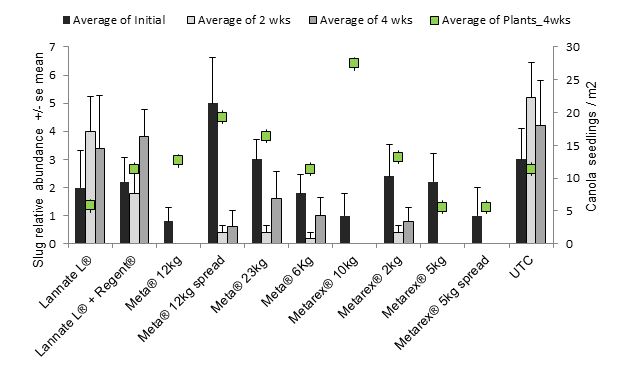
Figure 1: Abundance of black keeled slugs per refuge pre-treatment and two and four WAA and canola seedlings m-2 response at four WAA to treatments applied in Jun-July 2015 at Roseneath, Victoria, Australia. Slug pellets were applied on top of seed row (banded) at various rates (kg/ha) or spread (S).
ɸMetarex label rate is 5-8 kg/ha and Meta label rate is 5-7.5kg/ha. Growers should always follow label recommendations.
Conclusions
The targeted placement of bait around emerging seedlings gave no significant improvement in protecting the crop from slugs. Canola can be established with disc-seeders into stubble in the HRZ as long as some basic rules around timing of bait application are followed. Soil moisture at 50-60cm was associated with increased grey field slug activity at the soil surface as recorded by using surface refuges during this project.
Was this page helpful?
YOUR FEEDBACK
